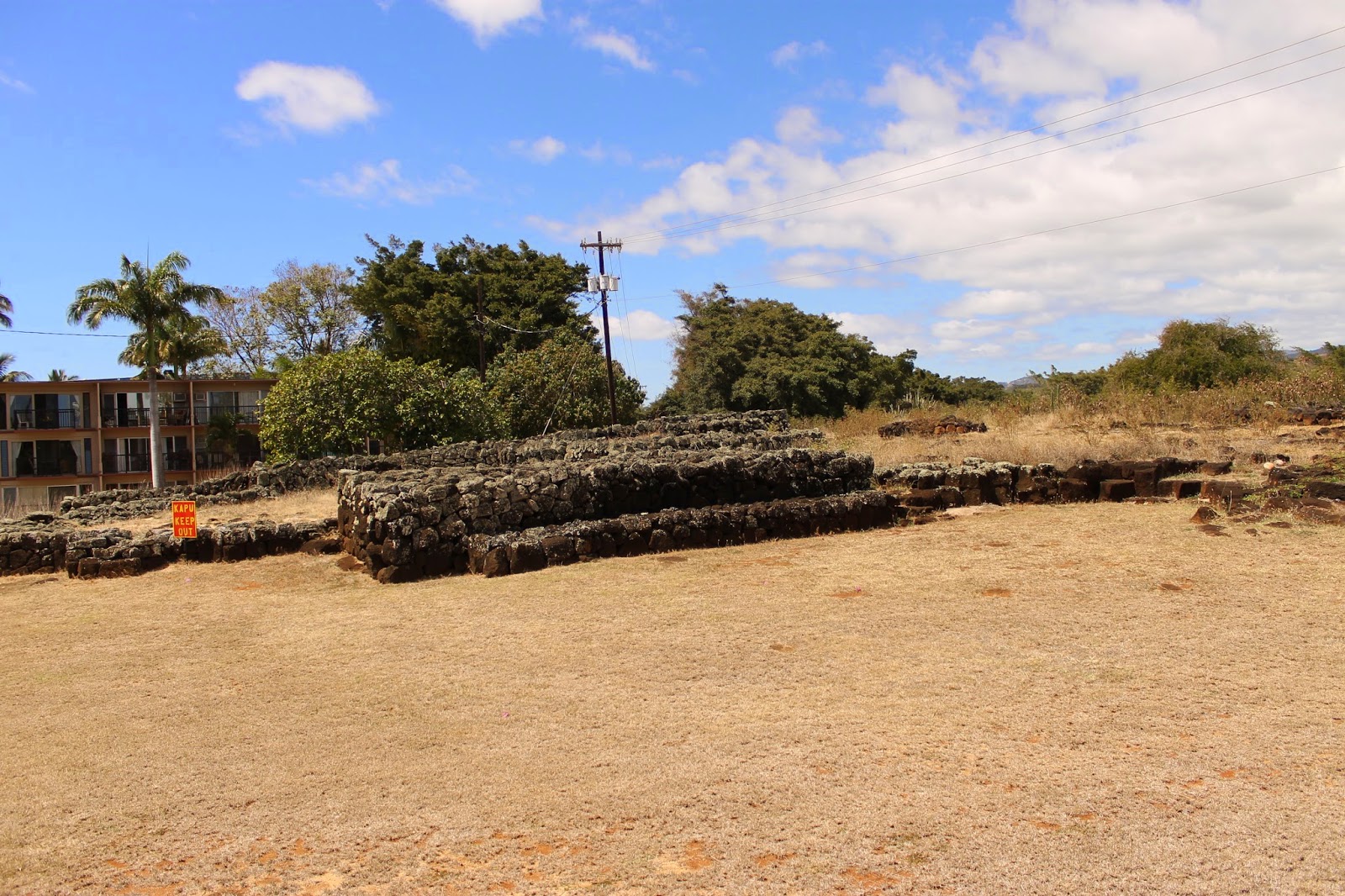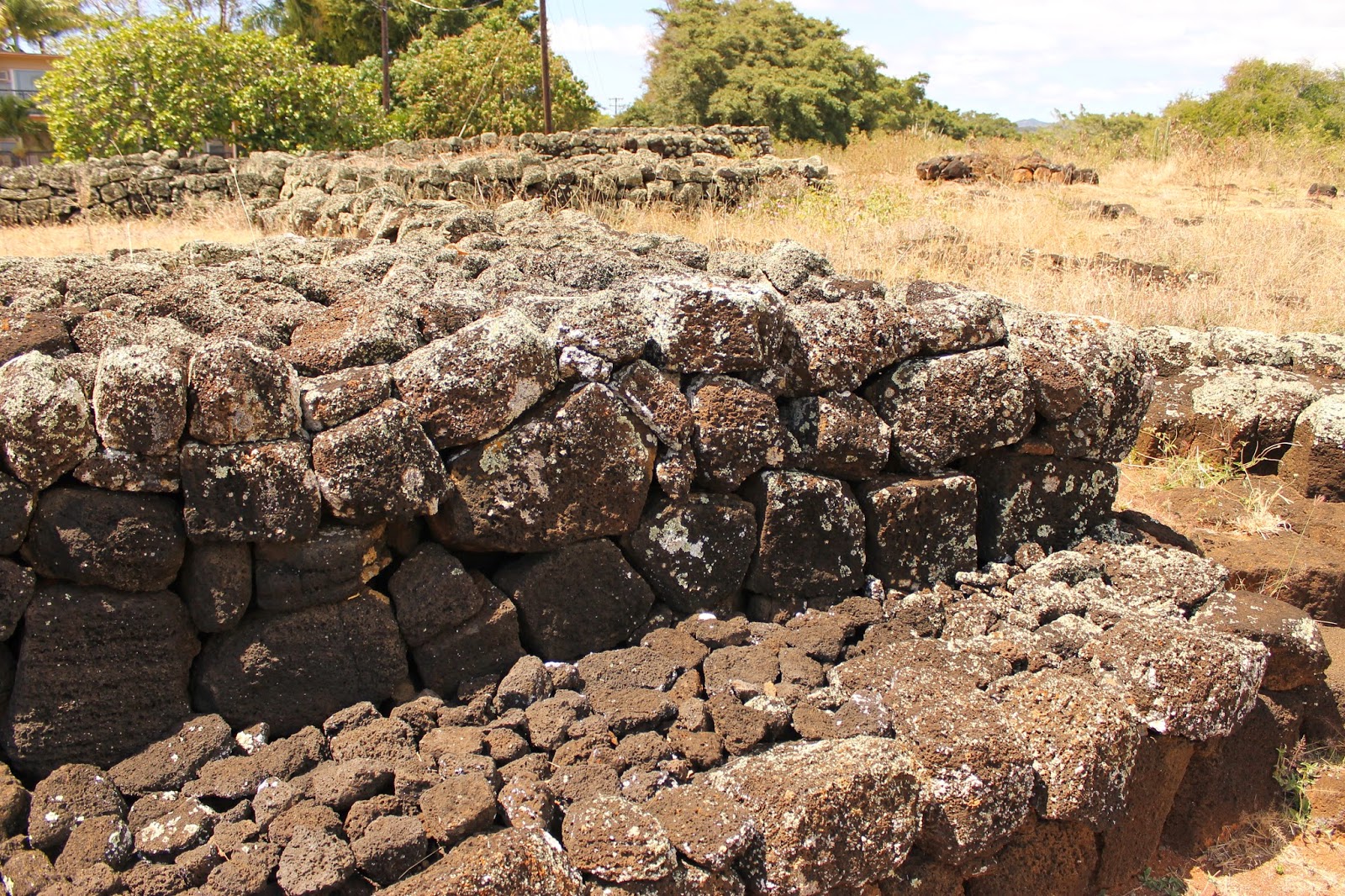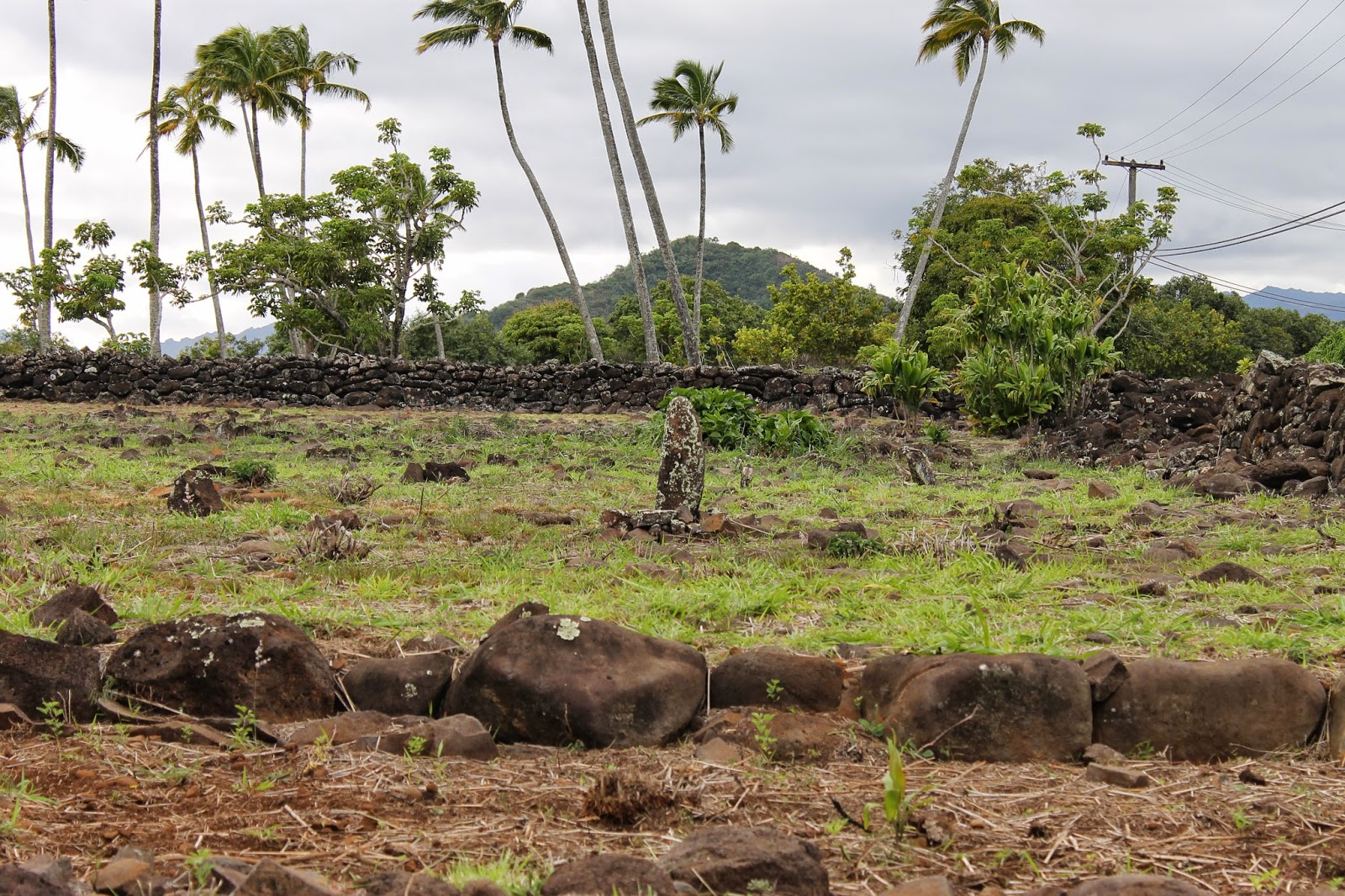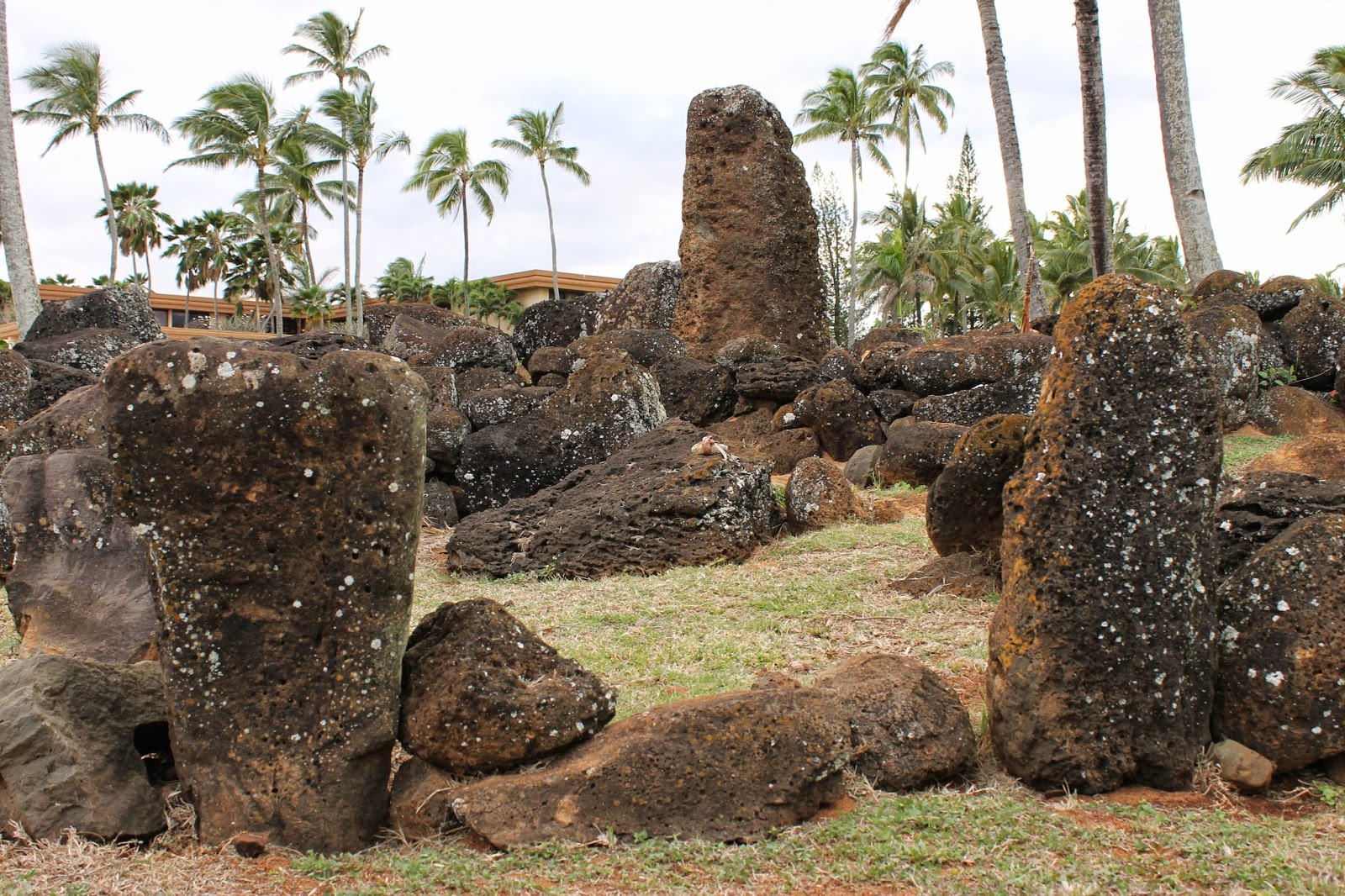After Ha'ena we headed back down to Lihue where our airbnb was. On the way I decided to chance discovering Wailua with the remaining hours on our first day in Kauai.
Poliahu Heiau is easy to get to simply following Kuamoo Rd. off of Kuhio Hwy. There is ample parking and a couple of display boards at the lookout. Explaining the lay of the land in relation to Wailua River and some of the ancient structures that remain to still be seen.

Ancient settlers from the Marquesas led by Punanuikaia'aina placed a kapu on the boundary of Wailua from the ocean to Mauna Kapu on both sides of Wailua river and the ridges of Nounou and Kalepa. From those ancient days Wailuanuiaho'ano was the seat of royalty and center of the ancient religion of Kauai. His grandson, Puna'aikoa'i'i was famous throughout the archipelago as a merciful chief that upheld the kapu and kept the ali'i under him in strict standards. He gained favor from the commoners and he gathered the young warriors to practice mock battles and compete in athletic sport. His daughter, Hina'aulua fittingly accepted a famous voyaging chief of Oahu and Kahiki to be her husband, Mo'ikeha. Mo'ikeha and his offspring lived here in Wailua and thus the Oahu and Kauai kingdoms were linked.

Under the shadow of the setting sun Mauna Kapu towers over Poliahu Heiau
Poliahu Heiau is one of the largest in Kauai at 242 feet by 165 feet.
There was a three floor, four sided oracle tower in the west corner covered in white tapa. Only the Ali'i nui and Kahuna nui were allowed to enter and talk to the gods.
Mauna Kapu at the edge of the Kalepa Ridge
Opaekaa Falls
Here is a glimpse into time with a reconstructed village beside Wailua River.
At the base of Kuamo'o ridge in which Poliahu Heiau stands. Just under Pu'uki, is Ka Lei O' Manu Heiau, wreath of manu.
The south west corner was the altar where animal and perhaps occasionally men were placed. A house was made inside the heiau for special dogs that were cared for by the Kahuna nui because of the actions of the dogs during sacrifices foretold the future...
Is this the door for the dogs house???
There was a cave that led underground to Wailua river. Where women and children would hide during times of war. The cave is closed now because of rockslides.
Next to Ka Lei O' Manu is Holoholoku Heiau. It was said to have been built at the command of Mo'ikeha as a birthplace for his line of ali'i and is named after his kahuna nui, to travel here and there at will.
The Pohaku Piko is where the naval cord was placed and the fate of the child would be foretold. In relation to how the piko was handled.
There is no explanation for this stone in front of Holoholoku. It could be an altar for offerings. Another theory is that of the bell stone, which I will cover more on later. This one looks just like one in a museum that the visitor can actually hit and it will make a sound similar to hitting an iron plate of metal...
This is the birthing stone and during royal births it would have been covered in tapa cloths and a house would be constructed over it. The chiefess in labor would sit on one boulder and lean on this. As far as I know this is a different account of those practiced at Kukaniloko in Lihue, Oahu. In which the mother is said to have been carried above the birthing stone. Although, if Mo'ikeha is accredited with building this heiau in his time. Then Holoholoku precedes Kukaniloko...
It kind of blows my mind that Mo'ikeha was here and that his children were born here. Although he had other children in other lands such as La'amaikahiki. Also that one of his youngest sons, Kila may have been born here and made the long journey to unite La'a with his father Mo'ikeha. Upon arriving, La'a is said to have brought two shark skin pahu drums to be stored in Holoholoku and they announced royal birth throughout the land.
Mo'ikeha's sons became chiefs on Oahu's Kona and Ewa moku. La'a goes to Kualoa, Oahu and marries three woman that give birth on the same night. Kila returned to rule Wailua but went to what was once Mo'ikeha and Olopana's valley of Waipio in Hawaii island. Since the two had to evacuate and migrate south generations before, due to a catastrophic flood or tsunami in Waipio.
When Mo'ikeha died, La'a brought his bones back to Kahiki with Kila. Mo'ikeha's granddaughter, Ka'ililauokekoa inherited the kingdom. She was wooed by Kauakahiali'i with his enchanting nose flute melody from deep within Wailua Valley at Pihakalani. During her reign a split between the chiefs of Kona and Puna district on Kauai began. Most likely because of the desire of her own beauty. Which was said to rival that of Laie'ikawai...
Someone left a crystal to charge in the sun here I guess...
Up on the hill above the heiau is an old graveyard. Fitting as the remains of the sacrifices below were said to have been left here as well...
A view of Kalepa Range and Mauna Kapu on the far right, as seen from Pu'uki hill
Fredrick B. Wichman "The" historian of Kauai recently passed away. He lived in Ha'ena and pretty much everything I learned of Kauai are from his books. He shared a story of a troublesome Niu tree that pestered a chief that lived in a coconut groove in the area. By dropping coconuts on his house while he slept and then dropping leaves to trip the chief when he came outside to find the trouble maker. The niu tree could stretch out from a distance to reach the chiefs home and could even pretend to almost be cut down only to heal itself and remain up right intact. Niulolohiki was the niu tree's name and it was the brother of the legendary hero named Maui. After speaking its name this kupua lost its power and was able to be cut down. Although its trunk's splinters grew into other niu that still drop coconuts on unsuspecting passersby.
This grove also made me imagine what the grove of Helumoa in Waikiki may have looked like...
On the shore across Wailua Bay is Kukui heiau. I was not able to visit it but it was said to have been made by the giant, Nunui with large stones and Ohia lehua logs far in the mountains. Nunui is now asleep as Nounou ridge's "Sleeping Giant"
On the south shore of Wailua River is Hikinaakala. It is a pu'uhonua, a place of refuge. A defeated warrior from a losing side of battle or someone that broke the kanawai kapu laws. Could run here and stay for awhile and then leave forgiven by their pursuers. In fact the trouble would be on pursuers if they chose to continue to seek vengeance on the person.
There is a pohaku piko here and not sure if the one below is it or if it was used to sharpen tools.
At the mouth of Wailua River are some stones that reveal petroglyphs when the river clears the sand off of them. I could not find any on my visit though...
Sorry I know I'm skipping all over Wailua as far as the images I'm sharing goes. Here is what I believe may be the bell stone of Wailua. This was the last place I visited on my first day on Kauai before the sun finally set.
I knew about where it as supposed to be by maps I've been studying prior to our trip. It is just below Poliahu Heiau on the ridge of Kuamo'o. Earlier when I was at Poliahu I walked down a dirt road but could not find anything significant. There were also two large pohaku under a tree next to the heiau that I thought might have been it. When I came out of the dirt road my wife was researching online to see if anyone had better images of it's location. I even asked a man parked on the side of the road feading chickens if he knew where they were. He told me that they were somewhere down the dirt road. But he lived nearby all his life and never found them.
I was a little frustrated and decided to head back into the dirt road and walk straight into the bushes.
I found two very large stones that stood a little higher than six feet and figured this must be the place. With all of the overgrowth cleared .These stones would clearly be seen from the river...
The mauka one had a petroglyph of a muscular man with a double arch rising from his shoulders over his head...
Here is the petroglyph viewed from the side.
Here is a small piko...
The makai stone seemed to make a different noise on the top of it (yes I tapped on them) as if some of the south side of it was hollow. As if a clinched fist of lava formed to cover some gap of gas inside...
The Pohaku Kani Bell Stones were used to notify the people of Wailua about important events at the heiau. They may have heralded the birth of an ali'i before the time of La'a's pahu drums. They may have also aligned with solar events.
I was very interested in finding a bell stone as I have been wondering what kind of stone makes what kind of sound. A stalk of Ki was used to create the sound in relation to the stone. Since reading about the one that once stood (now destroyed or taken) near Sacred Hearts on Waialae Ave. in Oahu. Both are recorded to have been heard from far away in their ahupuaa. Both are described as rounded which conflicts with the bell stone video I found on youtube of one that looked almost plate like and a pebble was used to hit it. I am unsure if either of these are the bell stone or if it is another red one nearby. Or if it was also taken or destroyed.
In 1824 after the rebellion of George Humehume, son of Kaumuali'i the last sovereign Ali'i Ai Moku of Kauai. Kaahumanu had the temples destroyed at the end of the Kapu System. A Christianized priest named Huleia chipped the bell stone.
Under what looks like a chipped section of the makai stone I found some smaller round stones, kukui, and some kind of lace looking fabric...
The bell stone is also said to have been used by people at Poliahu to communicate with another heiau toward the ocean, Malae Heiau. Also known as Malaea, Makakaukiu, and Mana heiau.
I feel bad for underestimating this heiau. I thought it was going to be covered in overgrowth and not really anything significant. I actually passed it on the first day and returned to Wailua the following morning just because we were planning on eating at Pono Market for breakfast.
Upon arrival I parked on the side of the road and I noticed a truck there and someone watering plants. I approached this slender man as he shrugged to himself like, hmm I wonder what these people are doing here. I asked him my all to well used phrase. Something like, do you know any moolelo about the heiau here? He suprised me with his reply. He asked me, why do you want to know? I got a little cocky and said because I'm Hawaiian and I want to learn about places like this. He elevated the situation and struck me with a mind blower. He say's, you aren't Hawaiian. You're a kanaka!
I could tell this person was special and that like others I've met along my journey of seeking the truth. He was right up there with the likes of Shad Kane from my first blog post. Or Kaleo Paik during my visits at Hawea. This man, that only identified his self later as Mark. Was the main man to be talking to about Malae Heiau and the district we were in. Which he bitterly explained, is rightfully named Nawiliwili. He told me about how we are children of the land and that Hawaii is only named so because of the conquering of foreign rulers upon it. He told me that while he was here cleaning the area one day, which he has done a very awesome job of. He was approached by a representative from OHA along with sheriffs and other people that were trying to remove him from there. He fought back proudly and told them he has a right to be there because of his religion and that their very own laws protected him. They left him alone after that.
He said he has been on a spiritual journey for most of his life and even traveled to other countries and spoke to shamans to learn what was the correct way of life.
He came to the conclusion that life is a gift from one higher source. All we have is nature and our skin form to enjoy it. Everything is what you yourself make of it. Your piko is all that you are and whether you stayed true to yourself that is the last thing you will take with you when you leave.
That is about all I can recall from what seemed like a long conversation on the side of a road. It was very powerful though. We shared breath, honi honi. Then he welcomed us to go and see the heiau...



Malae Heiau is said to have been built by the menehune that came with Ku'alunuipaukumokumoku. It's gigantic at 273 feet by 324 feet. The stone walls are 7 to 10 feet high and 8 feet wide. Inside the heiau is a ledge 2 feet above ground and 6 feet wide. The corners overlap and are buttressed with 13 foot walls. Like no other in Hawaii. The heiau is also known as Maka'Ukiu "source of the 'ukiu wind."
There is a wide cleared section surrounding the entire heiau but the growth inside is not cleared and is left undisturbed. It's crazy to imagine that Mark is doing this all by himself. I just love the amount of preservation Kauai heiau receive but at the same time they are clearly marked on maps and signs are posted educating the visitor. On all of our heiau visits there were other people arriving to pay respects and see what they could find, but not here.
Poliahu's coconut trees can be seen in the distance from Malae. Depending on what the fauna of ancient Kauai was. The two heiau might have been able to be seen from either location.
That thing about how Kauai has a lot of chickens is pretty legit but in my honest opinion spider webs crossing random urban and rural places is pretty darn abundant as well. This spider was on my leg for who knows how long! I let it crawl away and I bid it goodbye along with Malae heiau. When we got back to the road side Mark was already gone...





















































































































